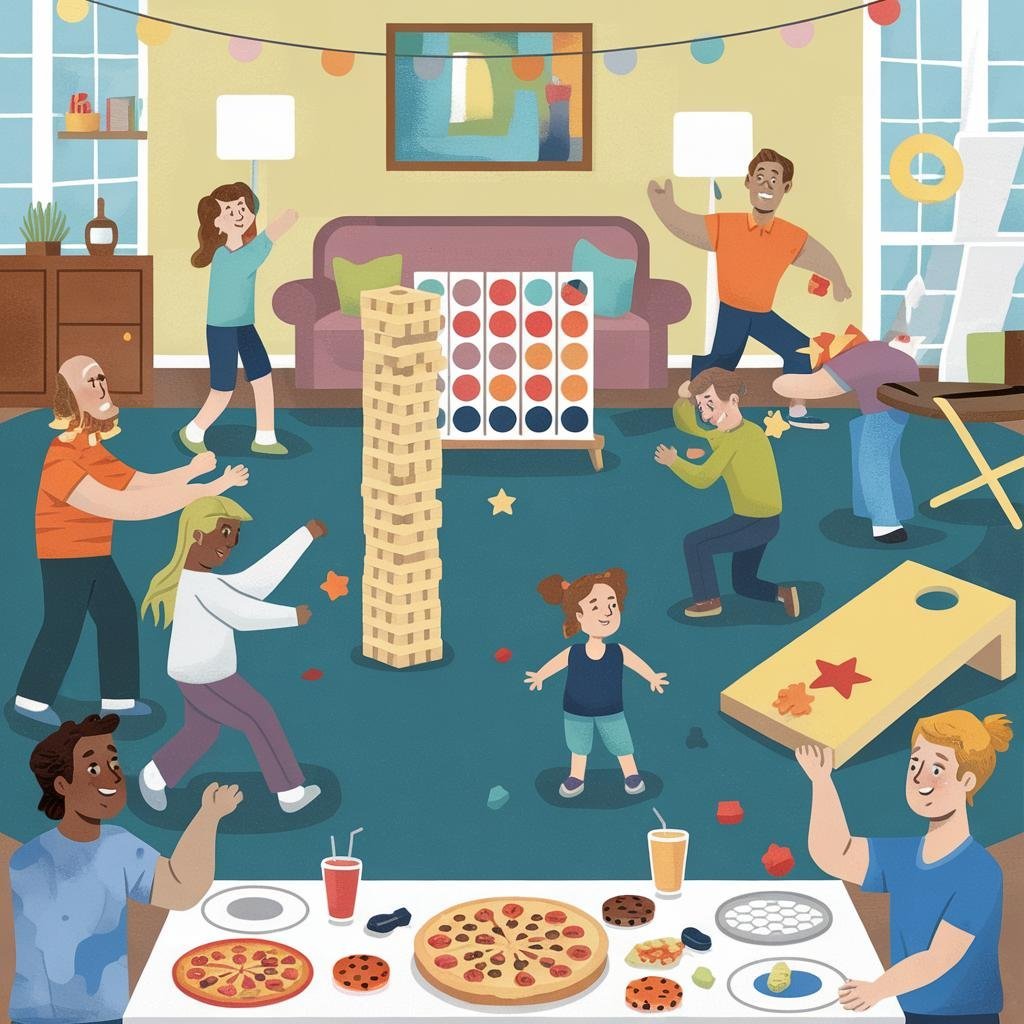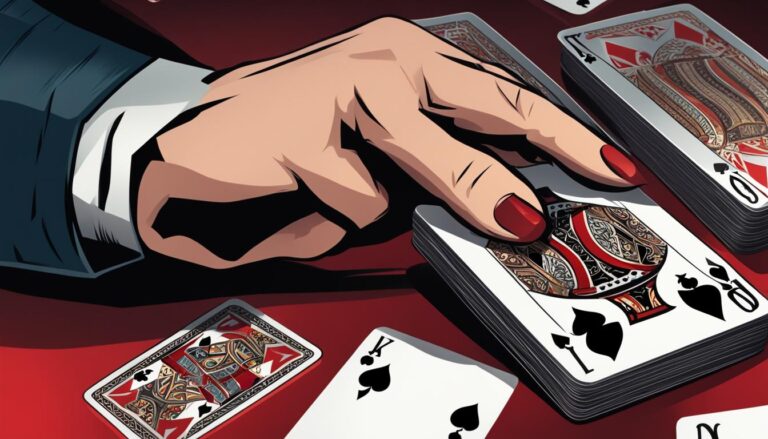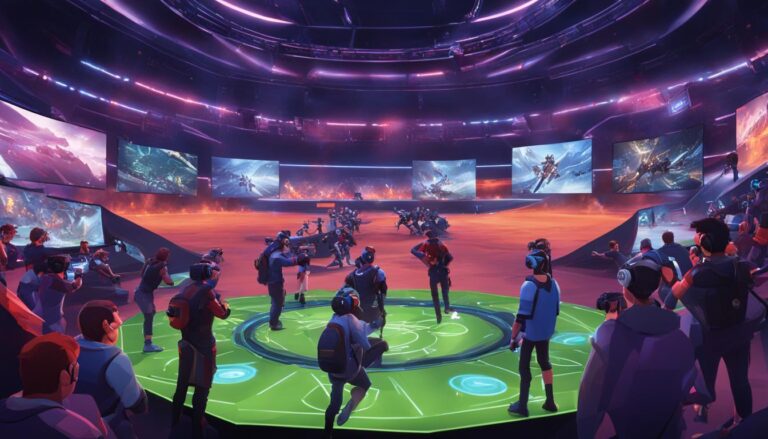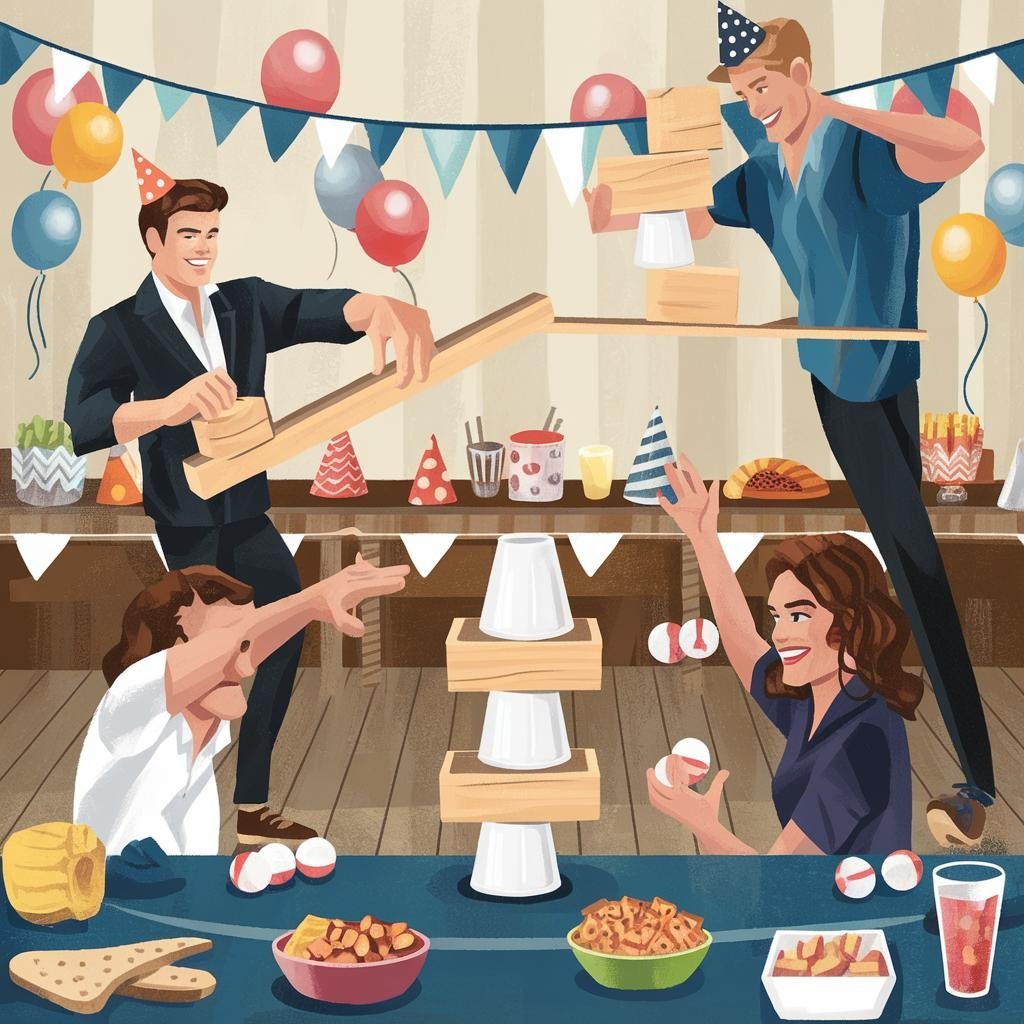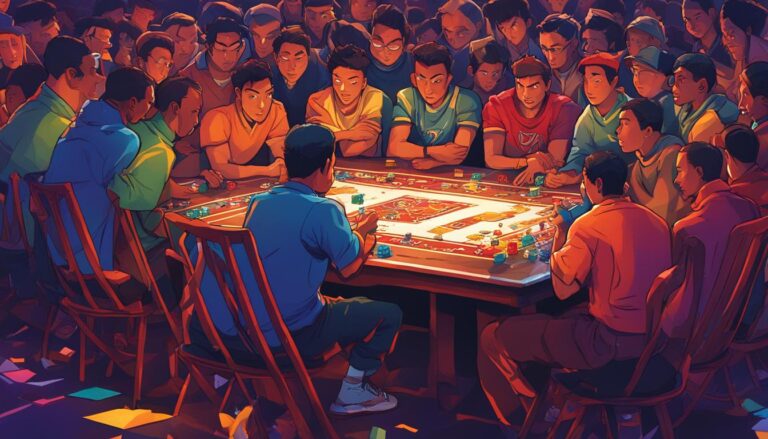Disclosure: This Post Contains Affiliate Links; We earn a commission on purchases.
Are you ready to embark on an exhilarating journey filled with brain teasers, logical thinking challenges, and mind-bending puzzles? Look no further than escape room games! These immersive experiences offer clue-based adventures and interactive escape games that will put your problem-solving skills to the test.
Escape rooms have gained popularity as team-building games and thrilling entertainment options. Whether you’re planning a game night with friends or a corporate team-building activity, escape room puzzles provide an exciting and memorable experience for all participants.
Immerse yourself in a world of challenging riddles and puzzles that require teamwork, ingenuity, and quick thinking. From deciphering codes and unlocking locks to finding hidden clues and solving intricate puzzles, escape rooms offer a wide range of immersive puzzle experiences that will keep you engaged and entertained throughout the game.
Join forces with your friends, family, or colleagues to tackle these challenging puzzles together. Escape room games provide an opportunity to strengthen bonds, enhance communication skills, and foster collaboration in a fun and engaging environment.
So, gear up for an exciting adventure and get ready to put your wits to the test in an escape room game night like no other!
Key Takeaways:
- Escape rooms offer immersive puzzle experiences that challenge logical thinking and problem-solving skills.
- Escape room puzzles can be enjoyed as team-building activities or thrilling entertainment options.
- Engage in a variety of challenging riddles, mind-bending challenges, and clue-based adventures.
- Escape rooms provide an opportunity for teamwork, bonding, and enhancing communication skills.
- Prepare for an exciting adventure and put your wits to the test in an escape room game night!
Table of Contents
Using Riddles as Clues
Riddles are a clever and intriguing way to engage players in escape rooms and help them solve challenging puzzles. By incorporating riddles as clues, game designers can add an extra layer of excitement and mystery to the gameplay experience. These clue-based puzzles can be strategically placed within the game environment, written on walls, or integrated into props to provide hints and guide players in the right direction.
But riddles can also be transformed into puzzles themselves, where players must unravel the riddle’s answer to unlock locks or open doors. This adds an interactive element to the gameplay, requiring players to think critically and connect the coded message within the riddle to a specific action or solution.
To create a seamless gameplay experience, it is essential to link the riddle with the problem or puzzle it corresponds to. Proximity and visual clues can be used to connect the riddle to its associated challenge, ensuring that players understand the relevance and purpose of the clue. This way, players are not left feeling confused or disconnected from the overall puzzle-solving process.
Using riddles as clues adds an extra layer of depth to escape room games, keeping players engaged and entertained as they decipher the hidden messages and solve the interconnected puzzles. It also encourages critical thinking, lateral thinking, and creative problem-solving skills, providing an immersive and intellectually stimulating experience.
Creating Engaging Riddle-based Puzzles
When using riddles as clues, it’s important to consider the difficulty level and audience of the escape room game. The riddles should challenge players without being too frustrating or discouraging.
Here are a few tips on creating engaging riddle-based puzzles:
- Choose riddles that align with the theme or storyline of the escape room.
- Ensure the riddles provide enough information without giving away the solution too easily.
- Use visual cues or props to enhance the riddle and make it more immersive.
- Vary the types of riddles used, including wordplay, lateral thinking, or mathematical riddles.
- Consider the language and wording of the riddles to make them accessible to players.
By incorporating well-crafted riddles into escape room games, designers can create a truly captivating experience that challenges players’ intellect, creativity, and problem-solving abilities.
Enigmas: Riddles with Metaphors and Similes
Enigmas are a fascinating type of riddle that captivate players with their clever use of metaphors and similes. These riddles challenge participants to decipher descriptions of objects or concepts that are disguised in surprising and unusual ways. A classic enigma riddle often begins with the question, “what am I?” Here, players must unravel the enigma by making logical connections between the clues embedded within the metaphorical language and the ultimate solution.
Enigmas immerse players in a world of figurative language, where the answer lies in the intersection of poetry and problem-solving. By employing metaphors and similes, enigmas heighten the challenge by requiring players to look beyond the literal interpretation of the words. Successfully solving an enigma riddle requires both an astute understanding of the clues and the ability to think creatively to uncover the hidden meaning.
Enigmas unlock a realm of possibility, transporting players to a universe of metaphorical marvels and simile-infused surprises. These riddles push the boundaries of logical reasoning, inviting participants to delve beyond the surface and uncover the intricate web of connections that lie within.
When incorporating enigmas into escape rooms, it is crucial to design puzzles that lead players towards tangible objects or solutions. Visual and prop hints provide players with essential guidance as they navigate through the enigmatic world, encouraging them to explore, inspect, and interact with their surroundings in search of the elusive answer. By integrating these solution hints subtly into the escape room’s environment, players experience a seamless and immersive gameplay adventure.
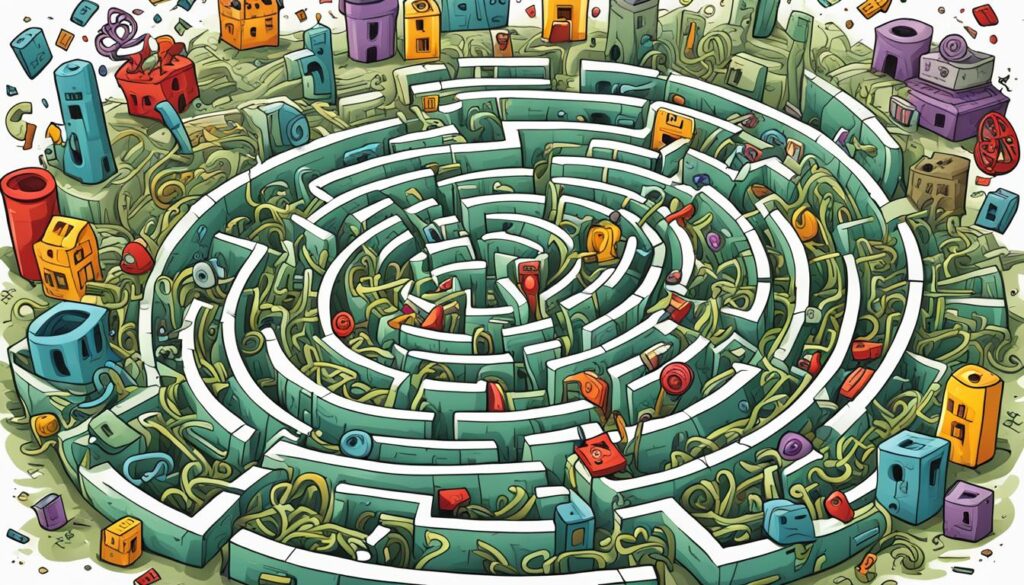
Sample Enigma Riddle
I am a key without a lock,
A treasure without a chest,
A sensation without a touch,
A secret without a guess.
What am I?
Solution Approach:
- Identify the metaphors and similes used: key without a lock, treasure without a chest, sensation without a touch, secret without a guess.
- Look for a common thread or theme connecting these elements.
- Consider abstract concepts that fit the description.
- Apply logical connections between the clues and the potential solutions.
- Based on the enigma’s clues, the answer could be “a memory.” Memories are intangible but hold value, evoke sensations and emotions, and remain locked away until recalled.
Enigmas add an element of intrigue and intellectual stimulation to escape rooms, ensuring an unforgettable experience for all participants. By incorporating these metaphorical riddles into your game design, you will challenge players to think beyond the obvious and discover the extraordinary hidden within the ordinary.
Conundrums: Puns and Wordplay Riddles
Conundrums are riddles that weave puns, double-meanings, and clever wordplay into unexpected answers. These riddles often take the form of jokes and can prove challenging to solve as the clues don’t always have a straightforward logical connection to the solution. In escape rooms, conundrums add an exciting twist as players must focus on the words themselves, delving into the depths of their linguistic knowledge to decipher the intended meaning.
Imagine being presented with a riddle that reads: “Why don’t scientists trust atoms? Because they make up everything!” The pun here lies in the double meaning of “make up,” which can refer to both forming everything and falsifying information. Players must exercise their wit and knowledge of the English language to unravel the conundrum and arrive at the answer, “atoms.”
“Why don’t scientists trust atoms? Because they make up everything!”
Conundrums in escape rooms can take the form of word puzzles, where players must dissect the clues and search for hidden meanings within sentences or phrases. A well-crafted conundrum can lead the players down a path of misdirection, challenging their ability to think beyond the literal interpretation of words.
To guide players towards the solution, visual cues and prop hints can be strategically placed within the escape room. For instance, a picture on the wall featuring a rebus or a series of visually connected images could serve as a clue to unlock the conundrum. By utilizing these visual aids, the escape room designers provide players with additional resources to navigate through the wordplay and uncover its witty secrets.
Visual and prop hints can be utilized to direct players towards the solution.
Conundrum riddles encourage players to think outside the box, testing their linguistic prowess and ability to decipher the clever intentions of the puzzle creator. By incorporating conundrums into escape room experiences, players are rewarded not only with the satisfaction of solving a challenging riddle but also with the joy and amusement that stem from a well-crafted play on words.
Pro Tip: Engage in a Battle of Wits
Incorporate conundrums that incorporate familiar puns and wordplay based on popular culture references. This adds an extra layer of enjoyment as players can reminisce about their favorite movies, books, or songs while trying to crack the code.
So buckle up and get ready to embrace the world of conundrums, where every word holds a deeper meaning and laughter ensues from the unexpected twists that lie hidden within the riddles.
Observational Riddles: Noticing Inconsistencies
Observational riddles provide players with thrilling scenarios, often involving murder mysteries, where they are challenged to notice inconsistencies or lies scattered throughout the details presented. These cleverly crafted riddles require players to make logical connections, serving as virtual detectives tasked with uncovering the truth. By carefully observing the clues and piecing together the puzzle, players can unravel the mystery and arrive at the solution.
In escape rooms, observational riddles take gameplay to a whole new level by creating an immersive and engaging experience. Players become active participants, keenly searching for clues and solving puzzles based on their observations. Each detail holds a piece of the puzzle, and players must critically think and connect the dots to progress in the game. The suspense and excitement build as players dive deeper into the mystery, driven by the thrill of uncovering the truth.
Whether it’s analyzing crime scenes, examining witness statements, or deciphering hidden messages, the power of observation is key. Players must pay attention to every detail, no matter how insignificant it may seem, as these inconsistencies hold the key to solving the riddles. By honing their detective skills and utilizing their powers of deduction, players can effectively navigate through the intricacies of the mystery.
Escape rooms that incorporate observational riddles offer an immersive and satisfying gameplay experience. As players uncover each inconsistency, they feel a sense of accomplishment and fulfillment. These riddles not only entertain but also challenge players’ critical thinking abilities, fostering cognitive skills and logical reasoning.

Observational riddles create a captivating environment that enables players to put their detective hats on and immerse themselves in the world of crime-solving. The thrill of uncovering hidden truths, the rush of discovering hidden clues, and the satisfaction of unraveling complex puzzles make for an unforgettable experience. Escape rooms that incorporate these challenges offer a unique opportunity for players to test their detective skills, work as a team, and create lasting memories.
Switcheroo Riddles: Playing with Perception
Switcheroo riddles are a fascinating twist on traditional puzzles, designed to challenge and deceive players by deliberately playing with their assumptions and perceptions. These clever riddles often trick players into mistaking the nature of the puzzle, leading them down the wrong path before they even realize it.
Unlike straightforward riddles that follow a linear path, switcheroo riddles require players to step back and engage in alternative thinking and outside-of-the-box strategies. They encourage individuals to question their preconceived notions and explore different perspectives in order to break free from the misdirection that is cleverly woven into the puzzle itself.
Escape rooms provide the perfect environment for incorporating switcheroo riddles. In these immersive experiences, players are already on high alert, searching for clues and solving puzzles. By introducing switcheroo riddles, escape room designers can take the challenge to a whole new level, pushing players to think creatively and question their own assumptions.
Switcheroo riddles not only test players’ puzzle-solving skills but also their ability to think critically and adapt to unexpected scenarios. They enhance the overall escape room experience by adding an element of surprise and encouraging players to explore alternative paths.
Embracing Misdirection for Mind-Bending Challenges
Switcheroo riddles are a form of misdirection, a technique used to manipulate perception and guide players away from the correct solution. By embracing misdirection in escape room puzzles, designers can create mind-bending challenges that require players to unravel the layers of deception and discover the hidden truths beneath.
“Appearances can be deceiving, and switcheroo riddles take full advantage of this fact. They lure players into a false sense of security, only to reveal surprising twists and turns along the way.”
These puzzles force players to think beyond the obvious, encouraging them to explore new possibilities and consider alternative perspectives. The ability to think outside the box becomes essential as players must break free from the constraints of their assumptions and embrace a different line of thought.
Switcheroo riddles challenge players to approach puzzles with an open mind, utilizing alternative strategies and unconventional thinking. They encourage individuals to question everything and consider multiple solutions, ultimately leading them to the correct answer by breaking away from traditional expectations and exploring new avenues of thought.
Experiencing the Power of Perception Puzzles
Switcheroo riddles are a prime example of perception puzzles, where the way we perceive a problem or situation directly influences our ability to solve it. These puzzles teach us that sometimes, what we initially perceive may not be the reality, and that there are layers of complexity hidden beneath the surface.
By incorporating perception puzzles, such as switcheroo riddles, escape rooms provide an immersive experience that challenges players to question their own senses. They push participants to examine their surroundings more carefully, looking for subtle cues and hidden details that may unlock the solution.
Switcheroo riddles in escape rooms offer an opportunity for players to sharpen their observation skills and develop a more nuanced understanding of their surroundings. They encourage individuals to analyze the given information from different angles, fostering a mindset of curiosity and critical thinking.
Ultimately, switcheroo riddles and perception puzzles add an exciting layer of depth to escape room experiences. They compel players to think beyond the surface level, inviting them to embrace alternative thinking and explore the unexpected. By playing with perception, these riddles create a thrilling and utterly captivating experience that lingers in the players’ minds long after the game is over.
| Switcheroo Riddles: Playing with Perception | Benefits and Impact |
|---|---|
| Engage players by challenging assumptions and perceptions | Enhance critical thinking skills |
| Encourage alternative thinking and outside-the-box strategies | Promote creativity and exploration |
| Create mind-bending challenges for immersive gameplay | Foster an unforgettable escape room experience |
| Develop observation skills and attention to detail | Improve problem-solving abilities |
| Provide a unique and captivating puzzle-solving adventure | Encourage teamwork and collaboration |
Puzzle Ideas for Escape Rooms
Escape rooms provide an exciting and immersive experience for players, challenging their problem-solving skills and teamwork. To create engaging gameplay experiences, escape room designers can incorporate various puzzle types that align with different themes. Here are some puzzle ideas for escape rooms that can be implemented on a tight budget or with high-quality execution:
Puzzle Types:
- Extracting digits, letters, directions, and orders
- Decrypting messages using codes and ciphers
- Piecing together torn messages or jigsaw puzzles
- Searching for hidden items in odd places
By incorporating these puzzle types into escape rooms, designers can create interactive and immersive challenges that engage players’ problem-solving abilities and keep them hooked throughout the game.
Specific puzzle themes can also enhance the overall experience. Whether it’s a haunted house theme, a pirate adventure, or a futuristic escape room, incorporating thematic elements into puzzles can amplify the players’ immersion and excitement.
Example Puzzle Theme: Haunted House
In a haunted house escape room, puzzles can revolve around ghostly legends, hidden secrets, and paranormal phenomena. Here’s an example of how different puzzle types can be used within this theme:
| Puzzle Type | Description |
|---|---|
| Extracting Digits | The players must find and extract key digits hidden within spooky paintings to unlock a combination lock. |
| Decrypting Messages | To uncover a ghost’s message, players must decipher a cryptic message written in an ancient language using a provided cipher. |
| Piecing Together Torn Messages | Players discover torn diary pages scattered throughout the haunted house. By reconstructing the torn messages, they reveal the ghost’s backstory and solve the puzzle. |
| Searching for Hidden Items | Players must search through cobweb-filled corners and creepy furniture to find hidden keys that unlock a mysterious chest. |
By incorporating a variety of puzzle types within a specific theme, escape room designers can craft a cohesive and immersive experience that captivates players and keeps them engaged until the last puzzle is solved.
Remember, the key to creating an unforgettable escape room game night is to blend puzzle variety with an engaging theme, striking the perfect balance between challenge and enjoyment.
The Value of Escape Room Puzzles
While participating in an escape room, the puzzles and challenges are undeniably exciting and engaging. However, it’s important to recognize that the true value of the experience extends beyond the puzzles themselves. Escape rooms provide an opportunity for quality time spent with loved ones, fostering teamwork, bonding, and creating unforgettable moments.
When you enter an escape room, you enter a unique and immersive environment where collaboration is key. As players work together towards a common goal, they develop a sense of camaraderie and learn the importance of effective communication and cooperation. The experience of overcoming obstacles and conquering challenges together strengthens the bond between team members and creates lasting memories.
“Escape rooms provide a unique opportunity for individuals to bond and connect on a deeper level. Through shared triumphs and the collective experience of problem-solving, players forge stronger relationships and build a sense of trust and unity.”
In an escape room, the puzzles serve as a catalyst for meaningful interaction. As players navigate through the intricate maze of riddles and obstacles, they rely on each other’s strengths, expertise, and unique perspectives to move forward. This collaborative effort not only enhances problem-solving skills but also fosters a sense of synergy and camaraderie.
The shared accomplishments and moments of triumph within an escape room setting create a sense of fulfillment and pride. The joy of unraveling a complex puzzle or discovering a hidden clue reinforces the power of teamwork and builds confidence in one’s abilities. These memorable moments become cherished stories to be retold time and time again.
Ultimately, the value of escape room puzzles lies not only in the thrill of the game but also in the valuable lessons learned and the bonds formed. It’s an experience that goes far beyond solving riddles, offering an opportunity to connect with others, strengthen relationships, and create lasting memories.
So gather your team, embrace the challenge, and embark on an escape room adventure that will provide not only an unforgettable experience but also an opportunity for quality time, teamwork, bonding, and the creation of truly memorable moments.
Conclusion
Escape rooms offer thrilling and immersive puzzle experiences that are perfect for team building and problem-solving. Whether you’re planning a game night with friends or organizing a corporate team-building activity, escape rooms provide engaging gameplay elements that promote teamwork and critical thinking skills.
From solving challenging riddles and deciphering enigmas to noticing inconsistencies in observational puzzles and exploring alternative perspectives in switcheroo riddles, escape rooms offer a wide variety of puzzles to satisfy every player’s taste. These immersive games not only test your problem-solving abilities but also create lasting memories and bonding opportunities.
So, gather your team, unleash your logical thinking, and dive into the thrilling world of escape room puzzles. With their unique blend of excitement, challenge, and cooperation, escape rooms are the perfect choice for an unforgettable and immersive gaming experience. Get ready to unlock your potential and embark on a journey of teamwork, problem-solving, and unforgettable fun.

As the founder of Friends Game Night, Ryan channels his enthusiasm for gaming into a platform that celebrates the magic of gathering friends around the digital or physical tabletop. Through his website, Ryan shares insightful articles, reviews, and recommendations, aiming to inspire others to create their own memorable gaming moments.
Subscribe to Our Newsletter


